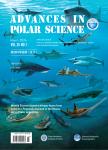Modeling the ocean circulation in the Bering Sea
Modeling the ocean circulation in the Bering Sea作者机构:Cooperative Institute for Limnology and Ecosystems Research (CILER) School of Natural Resources and Environment (SNRE) University of Michigan 4840 S State Road Ann Arbor Michigan 48108 USA NOAA Great Lakes Environmental Research Laboratory (GLERL) 4840 S State Road Ann Arbor Michigan 48108 USA
出 版 物:《Chinese Journal of Polar Science》 (极地研究(英文版))
年 卷 期:2008年第19卷第2期
页 面:193-211页
基 金:supports from IARC/JAMSTEC Cooperative Agreement,University of Alaska Costal Marine Institute NOAA RUSALCA International Polar Year modeling project awarded to JW.This is GLERL Contribution No.1502
主 题:Arctic Ocean the Bering Sea ocean circulation.
摘 要:With parameterized wave mixing, the circulation and the tidal current in the Bering Sea were simulated simultaneously using the three-dimensional Princeton Ocean Model. The simulated circulation pattern in the deep basin is relatively stable, cyclonic, and has little seasonal change. The Bering Slope Current between 200-1000 m isobaths was estimated to be 5 Sv in volume transport. The Kamchatka Current was estimated to be 20 Sv off the Kamchatka Peninsula. The Bering shelf circulations vary with season, driven mainly by wind. These features are consistent with historical esti- mates. A counter current was captured flowing southeastward approximately along the 200 m isobath of the Bering Slope, opposite to the northwestward Bering Slope Current, which needs to be validated by observations. An upwelling current is located in the shelf break ( 120-1000 m) area, which may imply the vertical advection of nutrients for supporting the Bering Sea Green Belt seasonal plankton blooms in the breakslope area. The Bering Slope Current is located in a downwelling area.



